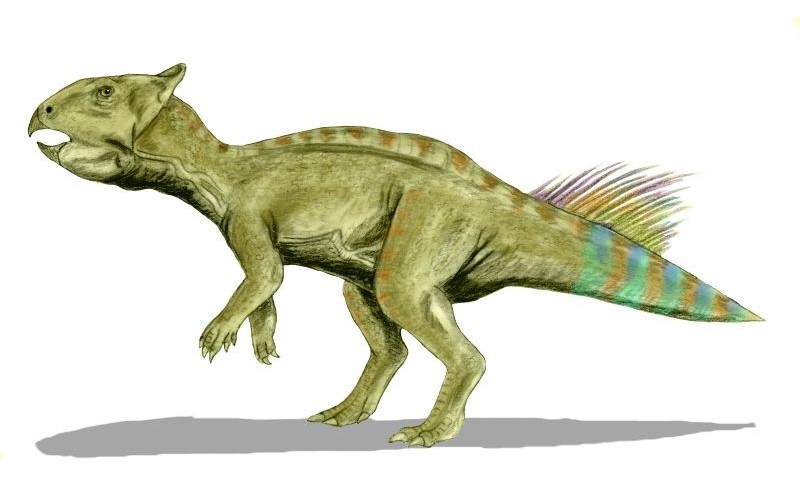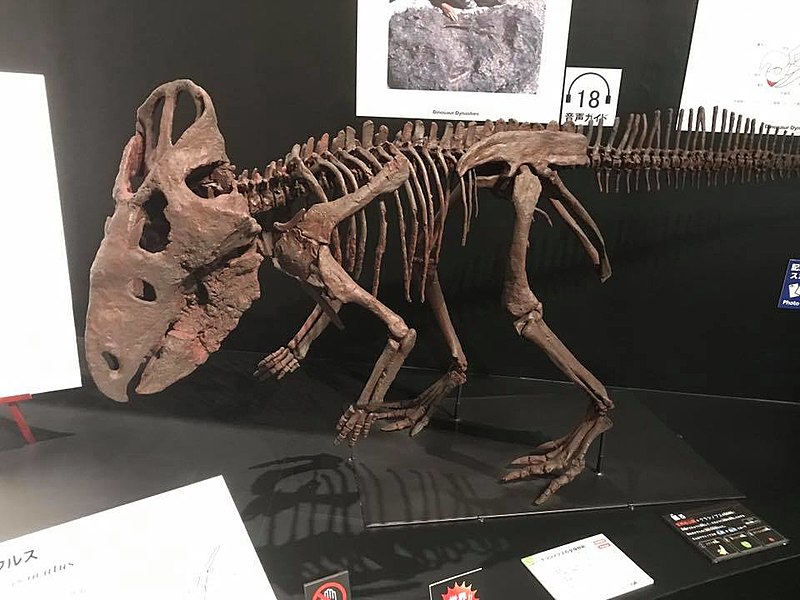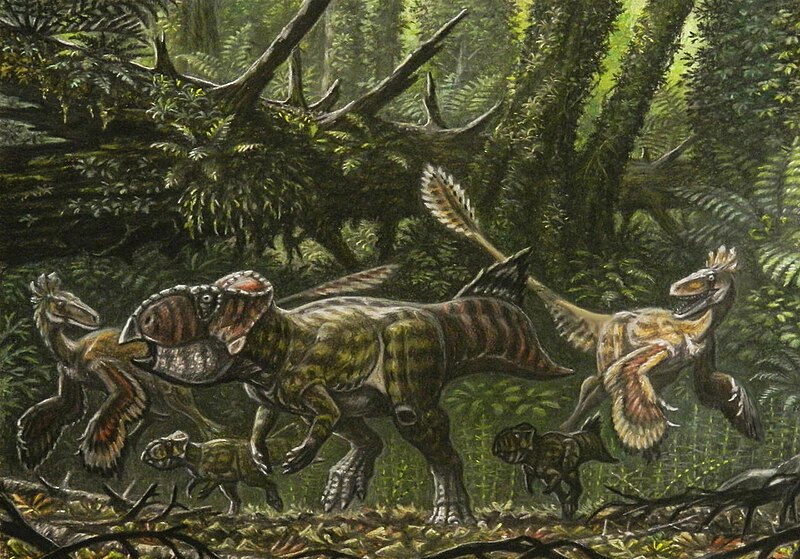Delving into the ancient world of dinosaurs, we often encounter fascinating creatures that tell us stories of a bygone era. Among these Cretaceous marvels is Cerasinops, a dinosaur whose very name, meaning “Cherry Face,” piques our curiosity. This journey through time reveals not just a creature but a window into a past world, evoking awe and wonder about the mysteries of our planet’s history.
Cerasinops, a Cerapod hailing from the verdant landscapes of the Late Cretaceous Period, stands as a testament to the incredible diversity of life that once flourished on Earth. It’s a reminder of the ever-changing nature of life, and how each creature, big or small, plays a pivotal role in painting the full picture of our planet’s vibrant past.
Cerasinops Key Facts
| Keyword | Fact |
|---|---|
| Pronunciation | Seh-rass-e-nopz |
| Meaning of name | Cherry Face |
| Group | Neoceratopsia |
| Type Species | Cerasinops hodgskissi |
| Diet | Herbivore |
| When it Lived | 83.6 to 72.1 MYA |
| Period | Late Cretaceous |
| Epoch | Campanian |
| Length | 8.2 feet |
| Height | Approximately 3.0 feet at hips |
| Weight | 386.0 pounds |
| Mobility | Moved on two or all four legs |
| First Discovery | 1983 by Jack Horner |
| Described by | 2007 by Brenda Chinnery and John (Jack) Horner |
| Holotype | MOR 300 |
| Location of first find | Two Medicine Formation, Montana, USA |
Cerasinops Origins, Taxonomy and Timeline
The name Cerasinops, derived from Greek, where ‘kerasi’ means cherry and ‘ops’ face, is as intriguing as the creature itself. The combination of these words into “Cherry Face” not only lends it an almost whimsical title but also offers a glimpse into the naming conventions of paleontologists, often inspired by unique features found in fossils.

Belonging to the Neoceratopsia (Dinosauria: Ceratopsia), Cerasinops finds its place in the Leptoceratopsidae. As the type species Cerasinops hodgskissi, it stands unique in its classification, illustrating the intricate web of dinosaur taxonomy.
Tracing the timeline of this fascinating dino, we journey to the Late Cretaceous Period, specifically the Campanian. This creature roamed our planet between 83.6 and 72.1 million years ago, a time marked by significant geological and climatic changes, setting the stage for its evolution and existence.
Discovery & Fossil Evidence
The discovery of Cerasinops in 1983 by Jack Horner at the Two Medicine Formation in Montana was a momentous occasion in the field of paleontology. This find, while not earth-shattering, added valuable knowledge to our understanding of the diverse dinosaur fauna of the Late Cretaceous.

Further exploration of this period has led to additional discoveries, enriching our understanding of Cerasinops’ place in Cretaceous life. The fossils found, primarily comprising skeletal remains, offer insight into the physical structure and lifestyle of this dinosaur. Notable specimens, such as the holotype MOR 300, provide a tangible link to this ancient creature, allowing scientists to reconstruct its appearance and habits with a reasonable degree of accuracy.
Size and Weight of Type Species
Cerasinops, an intriguing member of the dinosaur kingdom, was described in 2007 by Brenda Chinnery and John (Jack) Horner from a remarkably complete specimen, MOR 300. This specimen, almost 80% complete, offers valuable insights into the physical stature of this dinosaur. It is estimated to have had a total body length of about 8.2 feet, suggesting a size that’s neither too large nor too small, but rather moderate compared to other dinosaurs of its era. The body mass of this herbivore was approximately 386.0 pounds, placing it in a category of dinosaurs that were agile and perhaps adept at navigating their terrain with ease.
The Dinosaur in Detail
Cerasinops stands out for its unique features, which not only differentiate it from its contemporaries but also shed light on its adaptive strategies. Its physical characteristics suggest a herbivorous lifestyle, adept at foraging and possibly displaying behaviors indicative of a social creature. The study of notable specimens has been crucial in piecing together these aspects, providing a clearer picture of how Cerasinops might have interacted with its environment and other species.
Contemporary Dinosaurs
In the lush, primeval landscapes of the Late Cretaceous, a delicate balance of life thrived, where Cerasinops, a modest herbivore, coexisted with a variety of fascinating contemporaries. Each day was a nuanced dance of survival and coexistence, as these giants navigated their shared world.

Gorgosaurus, a fearsome predator, loomed large in this ancient drama. Larger and more imposing than Cerasinops, this carnivore’s presence in the ecosystem presented a constant challenge. While it’s unlikely that the smaller, more agile Cerasinops was a primary target for Gorgosaurus, the mere presence of such a predator would have significantly influenced its behavior and habitat choices.
Contrasting the predatory might of Gorgosaurus was Edmontonia, a fellow herbivore. This heavily armored dinosaur, with its intimidating spikes and bony plates, likely shared feeding grounds with Cerasinops. Despite their different defenses – one relying on agility and the other on armor – they would have peacefully coexisted, possibly even providing inadvertent protection for one another against common predators.
In this tableau, another character, Sphaerotholus, shared the stage. This small ceratopsian, roughly the same size as Cerasinops, would have been both a competitor and a companion. Competing for similar food sources, these two herbivores might have engaged in gentle rivalry, yet their coexistence would have enriched the biodiversity of their shared habitat.
This vivid tapestry of life in the Late Cretaceous, with Cerasinops at its heart, paints a picture of a dynamic ecosystem. Here, amidst the towering conifers and lush ferns, these dinosaurs played their roles in a grand, interconnected story of survival, each contributing to the delicate balance of their ancient world.
Interesting Points about Cerasinops
- Blending of Continental Traits: Cerasinops hodgskissi uniquely exhibits anatomical features typically found in either Asian or North American ceratopsians, but not both. This includes traits like a fenestrated frill and premaxillary teeth, common in Asian taxa, and a specialized tooth wear pattern seen in North American species.
- A Bridge Between Continents: Serving as a vital link, this dinosaur bridges the taxonomic gap between Asian and North American basal neoceratopsians, showcasing characteristics of both groups in a single species.
- Potential for Bipedality: The anatomical and histological structures of Cerasinops suggest the possibility of bipedal locomotion, a trait not previously observed in basal neoceratopsians.
- Unique Combination of Features: Cerasinops possesses a mix of distinctive characteristics such as a fenestrated frill – a feature not described before in North American basal neoceratopsians, and premaxillary teeth, aligning it more closely with its Asian counterparts.
- Role in Dinosaur Dispersal Hypothesis: The discovery of Cerasinops supports the hypothesis of multiple dispersal events of basal neoceratopsians between Asia and North America, highlighting its significance in the biogeographical study of Ceratopsia.
Cerasinops in its Natural Habitat
Cerasinops thrived in an environment that was as dynamic as it was demanding. The landscape during the Late Cretaceous was marked by diverse vegetation and fluctuating climatic conditions, shaping a habitat that required adaptability and resilience. As an herbivore, Cerasinops navigated this terrain with ease, its diet likely consisting of the abundant plant life of its time. Its locomotion, potentially bipedal or quadrupedal, would have played a key role in its survival, whether in escaping predators or traversing the diverse geography of its home.
The social behavior of Cerasinops, though largely speculative, may have ranged from solitary to herd-like tendencies. The potential for complex interactions within its species and with others adds an intriguing layer to our understanding of its daily life. The role of Cerasinops in shaping its ecosystem, be it through grazing habits or other means, underscores the interconnectedness of life forms, no matter how ancient.
Frequently Asked Questions
Cerasinops displays a rare combination of traits found in both Asian and North American ceratopsians, such as a fenestrated frill and specialized tooth wear pattern. This blending of continental features makes it a unique species within the Ceratopsia.
The anatomical and histological evidence suggests that Cerasinops might have been capable of bipedal locomotion, a characteristic not typically associated with basal neoceratopsians.
Cerasinops plays a crucial role in understanding the dispersal of basal neoceratopsians between Asia and North America. Its characteristics support the hypothesis of multiple migration events across these continents.
With an estimated length of 8.2 feet and a weight of 386.0 pounds, Cerasinops was relatively small and gracile compared to larger ceratopsians like Triceratops and Centrosaurus.
Asian basal neoceratopsians often have fenestrated frills and premaxillary teeth, while North American species typically show a specialized tooth wear pattern. Cerasinops uniquely combines these traits from both continents.
Cerasinops represents an evolutionary link, exhibiting traits from both Asian and North American ceratopsians. Its discovery sheds light on the evolutionary pathways and biogeography of the Ceratopsia group.
Sources
The information in this article is based on various sources, drawing on scientific research, fossil evidence, and expert analysis. The aim is to provide a comprehensive and accurate overview of Cerasinops. However, please be aware that our understanding of dinosaurs and their world is constantly evolving as new discoveries are made.
This article was last fact checked: Joey Arboleda, 03-11-2024
Featured Image Credit: Nobu Tamura, via Wikimedia Commons
